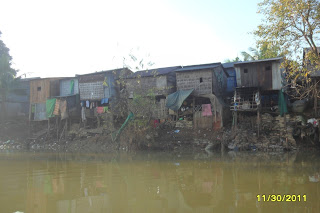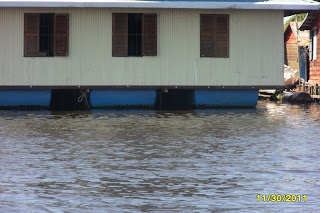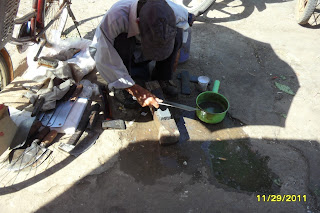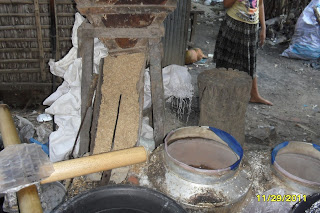Arrived in beautiful Siem Reap by boat this afternoon. All checked in to our fantastic hotel room, Sara is skyping her new beau upstairs and I am sitting around the beautiful pool trying to blog.
This may be our best day yet!! We were picked up by a very nice van at 6:45 am
The van dropped us at the boat dock for our river boat trip to Siem Reap. We were warned the top deck could get very hot as there is no cover. No seats either. So we sat inside as far away from the diesel engine as possible. There are no windows so good air flow but the trip was so spectacular I ended up sitting on the roof for the last 3 or 4 hours. We knew the trip would be 6-9 hours depending river height. Because they recently had so much flooding, the trip was relatively fast. About 7 hours. Probably depends on how many pick-ups and drop-offs as well.
 |
| Sara standing in front of our boat. Imagine a seven hour trip on this |
 |
| The roof of the boat where I sat for several hours. |
The trip started down a typical tropical river scene with palm trees and houses lining both sides of the river. As we got further out from the city, the river was very much like the Everglades. We had to duck frequently as branches were snapping into the boat and whacking our arms. The river was so lush and dense, we could only see the narrow water route in front of us. Sometimes another boat, coming toward us, would have to squish into reeds to let us by.
 |
| Houses along the river between Battambang and Siem Reap |
 |
| Fisherman |
 |
| Small viallage on the river. Note the cage with chickens in the middle |
Eventually we came to an open area and gradually all the plant life disappeared and it seemed as though we were on the ocean. The only land visible was what looked like a mountain far off in the distance and turned out to be Ankor, the main reason for our trip here
 |
| Phnom Kulen mountain that Tamara and I explored later in the week |
We had only one stop along the way where we could get off the boat. Of course we all had to take a bathroom break. There were 3 tiny stalls. You open a thin metal door and step off the dock onto a plank with a large square hole in it. So everyone goes right into the river. See yesterday's blog re:washing rice noodles in the river water.
 |
| Private bathroom stall off the dock at our only stop from Battambang to Siem Reap. Not sure if anyone uses the bucket to 'flush' or just wash themselves. There are other stall next to this one so I would not be pulling any water for any reason out of this hole. |
One thing I notice is no one is trying to sell us anything since we left Phnom Penh. Tourism has not overtaken the area yet. So nice!
Our river trip took us through many villages, some on land and some were on the water, either floating or on stilts in the water. All had boats at each house. We saw many dogs, cows and kids. Most of the cows we see are working cows so very skinny, almost skeletal. The water buffalo must be for eating because they are a bit meatier. Fun to see them wallowing in water ditches along side the road.
We made several stops in villages, more of a slow idle than a stop. Wood boats would paddle out to meet us to either pick someone up off the boat, pick up supplies or drop someone off. We saw folks get on at one village and get off at another. The whole scene is not unlike some of the native villages on the west coast of BC where everyone needs a boat to get around. We saw lots of folks fishing, usually with nets and almost always with old plastic water and coke bottles as floats for the net. Good recycling!

 |
| Large rain pots to gather fresh rain water |
 |
| Cows at small village along the river |
 |
| Family at work outside their home |
 |
| Woman delivering something. Many people cover their faces because of the dusty roads and they cover their arms so they don't get sun |
 |
| A passenger riding on the front of our boat. Note the narrow passage we had to navigate down the river. At several points, we were getting whacked by branches and bushes so we all had to duck and lean away from the outside of the boat. |
 |
| One of many passenger transfers. This family came to pick up dad off our boat. Pick ups and drop offs were done at every village by small boats rowing out to our boat as we passed through town |
 |
| mothers with kids running errands in town |
 |
| Kids wathcing us pass by |
 |
| kids waving as we pass by their home |
 |
| local floating market. This lady takes her boat to each home in this village and sells food |
 |
| one of many boats with small kids alone |
 |
| Houseboat. Note the antenna. This can't possibly be a TV can it? |
 |
| The river widens |
We saw a few egrets, pelicans and cormorants but for a floating jungle on the river, not many birds. I would have expected to see many. No bugs either so that is wonderful
 |
| The river eventually looked like an ocean. I think these are storks or pelicans. Black and white huge seabirds |
 |
| small boat had to squeeze into the brush to let our boat pass by |
 |
| dog greeting party. They must not get many walks, living on the water like this |
 |
| A floating school |
When we arrived in Siem Reap, we were met by a tuk tuk driver who took us to out hotel. Probably a 30 minute trip. The road was horrendous. Dusty red dirt with huge potholes. Big buses and cars were trying to navigate to the boat dock- you would never see a bus in a road like that in Canada. We were really tossed around and quite dusty when we arrived but the sight of the best hotel we have seen this trip made it all worthwhile. It was originally $31 but we upgraded to the executive suite for $42. Sara was doing dances in our sitting room there is so much room. She has never stayed in a real 4 or 5 star hotel. The Lebiz in PP was supposed to be. The Star hotel in Battambang was advertised as 3 star and looked nice but they reuse the top sheets on beds. We asked for a clean sheet but never got it. On both beds the top sheets are all wrinkled like they were tucked between someone's legs. Gross. We are both quite happy. Just had a delicious dinner and heading into the spa for a two hour massage. This is the life.

































































